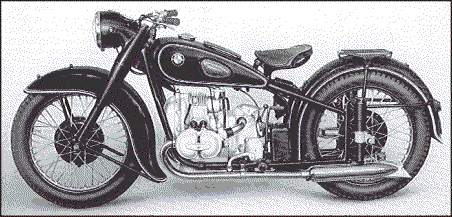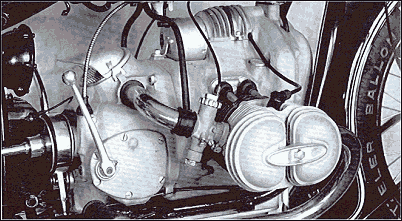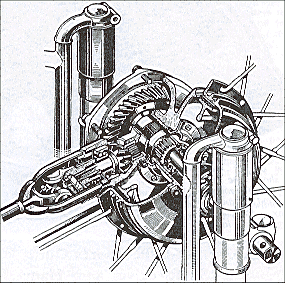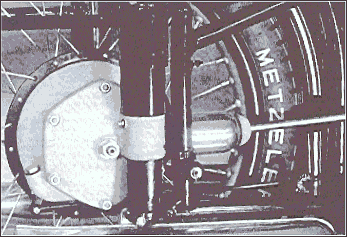
A quality German machine with appeal
BMW R51/2 494cc Transverse Twin

A quality German machine with appeal BMW R51/2 494cc Transverse Twin |
|
Nowadays, only one horizontally opposed BMW twin is in production. The
machine is basically similar to the R51 of 1939, but it incorporates a
few modifications, the most interesting of which is the redesigned
cylinder heads and overhead rocker gear. The pre-war 500cc was marketed
as a sports model, but no such claim is made for the current machine;
indeed, it has a general appearance which suggests a touring roadster
of demure performance. Therein lies one of its attractions, because
while the BMW R51/2 is well-mannered and pleasurable to ride at medium
speeds, it has a top-end performance that puts it in the sports
category and encourages the appellation "Jekyll and Hyde." Coil ignition is employed and it is switched on by depressing the body of the lighting switch fitted in the head-lamp shell. Each cylinder has its own carburettor fed through intake pipes connected to a single air filter sink in the top of the crankcase/cam gear box casing. The carburettors have no air slides; instead, there is an intake shutter at the mouth of the filter. |
 The BMW R51/2 had a hand shift as well as a foot shift. It is easily recognized by the split valve covers. The power unit is of attractively neat design and is beautifully finished. Throughout the test no oil leaks occurred. |
|
For cold starting it was found that an adequately rich mixture was
given by flooding the carburettors; the shutter was not employed. The
kick-starter crank is on the left side and has its axis in line with
the machine; the most convenient way to depress the pedal is with the
right foot while the machine is on its central stand. By British habits
this might seem to be an inconvenient necessity, but two factors lessen
any criticism that might be applied to this kick-starter layout. First,
the engine started readily whether it was hot or cold; secondly, the
tick-over was absolutely reliable, so that the chance of the engine
stalling was remote. Moreover, the engine idled so quietly and with the
ignition retarded so slowly that one felt almost encouraged to keep the
engine running for lengthy periods, when in similar circumstances with
many machines there would have been the inclination to stop the engine
and to restart it when ready to move off. Mixture strength to each cylinder, as supplied by the separate carburettors, was correctly balanced for idling and low speeds and indeed, as far as could be judged, for all speeds. Pick-up of the engine as the twist grip was turned was clean throughout the range. The twist grip has a longer travel--a slower action--than usual on British machines and was perhaps slightly heavy in operation. The operation of all controls was inclined to be heavy and the foot-change pedal sufficiently stiff in movement to become tiring at the end of a long day's run. With the machine stationary and the engine idling, the clutch freed satisfactorily so that bottom gear could be engaged without noise; one could not feel the operation of the gear-change mechanism through the pedal, which sometimes resulted in doubt as to whether the gear had been selected. The clutch took up the drive smoothly, though rather quickly. The machine as a whole is nicely balanced and could be ridden at very low speeds an maneuvered slowly in confined spaces feet-up without any special skill. In such circumstances the steering was light and entirely free from roll--as it was throughout the speed range. The transverse disposition of the cylinders makes it necessary for the footrests to be slightly farther back than on the majority of machines. Handlebar width is above average--thirty inches direct from tip to tip. At first, the riding position felt slightly unconventional, but after a few miles' experience was considered to have its merits, especially for the ease with which the footrests could be used for support. This is not to imply that the saddle was not up to its work--it was, in fact, commendably comfortable. Foot rests, saddle and handlebar are adjustable. The BMW is quiet mechanically and the silencers give an admirably subdued exhaust note. There is something more than absence of mechanical clatter. What noise does emanate from the engine is dull as as if insulated by say, very heavy oil. At town speeds, the BMW is pleasurable to ride. It encourages one to be in gentlemanly mood by reason of its quietness and easy acceleration. The engine pulls well and incites ambling in a highest gear in relation to road speed though there was the objection that there is a hardness in power delivery that can, indeed, be felt at speeds as high as nearly 40 mph when accelerating in top gear. Each power stroke can be felt. The "Jekyll and Hyde" characteristic of the machine is soon apparent when open roads are encountered. Three is a complete absence of high-frequency vibration, and as the revolutions mount the engine has the smooth, noiseless power flow of a turbine. Performance is zestful and because of the smoothness, quietness and effortlessness of the engine, speeds achieved can be deceptive. When driven as hard as open road conditions permitted, the engine proved tireless and remained unusually cool, as might be expected with the light-alloy cylinder heads so fully exposed to the air stream. Any top-gear speed above 40 mph to the maximum could be regarded as a comfortable cruising speed so far as the engine was concerned. |
|
To avoid clashing, gear changes had to be leisurely. When obtaining the
quarter-mile acceleration figures, it was found that third gear, if
engaged as rapidly as possible irrespective of the clashing of pinions,
slipped out of mesh. Perforce, therefore, gear changing had to be slow
for this type of performance data, and the hindrance is reflected in
the time and speed figures recorded. Both front and rear suspensions are inclined to be hard by modern British standards. For example, at dawdling speeds--say, 10 mph, over cobbles and tran-track inspection covers, the amount of front fork and rear lunger movement was negligible so that suspension was largely provided by the tires. Under average conditions, the suspensions, have a well-controlled movement, the slight hardness perhaps contributing to the marked degree of stability of the machine especially apparent during high-speed cornering. The steering was pluperfect (the damper was never brought into use) and the machine handled in the most confidence-inspiring manner without the lightest signs of drift or chopping-out when cornering fast on indifferent surfaces. Stability was also of a high order under wet road conditions; skidding was never experienced. The brakes of the machine tested did not match the performance, largely because the front brake lacked real power, no matter how much effort was given to applying the lever. |
 |
|
Throughout the test the engine remained free from oil leaks; the degree
of cleanliness was outstanding, with the crankcase retaining a
"just-from-the-showroom" appearance. Mud guarding was above average in
effectiveness. The beam from the head lamp gave a wide spread of light
of higher-than-average intensity, and the dipped beam, while adequate
for the rider; had a clean cut-off that ensured oncoming drivers were
not dazzled. Many detail features of the BMW appeal to the experienced rider. Both wheels are quickly detachable; the tools are carried in a tank recess provided with a lock; a locking bar is supplied which fits into mating fork and frame lugs and, when in position, ensures that it would be impracticable for the machine to be wheeled or ridden away. It is understood that modifications which are being introduced for the R51/2 will include the fitting of a prop-stand, and a narrower handlebar; on the new bar the clutch and brake levers will require a smaller hand span, and the operation of horn and dipper controls will be more convenient. SPECIFICATIONS: Engine: 494cc (68x68mm) o.h.v. horizontally opposed twin. Fully enclosed valve-gear operated by pushrods and twin chain-driven camshafts. Light-alloy cylinder heads and cast iron barrels. Light alloy pistons. Crankshaft supported by two ball bearings. Oil pump in crankcase reservoirs driven by skew gear and shaft from offside camshaft; reservoirs capacity, 3.5 pints. Compression ratio: 6.3 to 1 Fuel capacity: 3 gallons. Tires: Metzeler 3.50x19 inch studded front and rear. Brakes 7.87 inch diameter front and rear. Suspension BMW telescopic front fork with hydraulic damping; plunger type rear spring with coil compression springs and rubber deflection stops. Wheelbase: 55 inches. Saddle: Pagusa rubber pan type with tension spring anchored to nose pivot. Unladen height 29 inches. Ignition and Lighting: Bosch coil with manual advance by the handlebar lever. Gear ratios: Bottom 11.8 to 1. Second: 8.87 to 1. Third: 6.61 to 1. Top: 4.85 to 1. Single plate clutch in flywheel. Shaft secondary drive with flexible coupling at front and universal joint at rear. Spiral bevel final drive gears in oil bath; reduction ratio: 3.89 to 1. RPM at 30 mph in top gear approximately 1,900. Weight: 396 pounds Braking from 30 mph to rest on damp surface 31 feet Turning circle 16 feet Minimum non-snatch speed: 16 mph in top gear Weight per cc: .89 pounds Petrol consumption: At 50 mph 61 mpg Carburettor: Bing Spezial 1/22/29 and 1/22/30; twist grip throttle Air shutter on intake cleaner in upper gear box cover |
  Elaine's BMW R51/2 motorcycle restoration journal, page one |